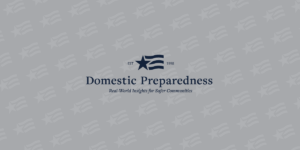

Avoiding the Threat Posed by Predictive Certainty
Michael Vesely
April 24, 2013
Trying to predict risks is a risk in itself. It is, of course, difficult to quantify numerically
the overarching risk involving a particular asset. However, the more complex the assessment model used,
the less likely it is that most people will understand it and the greater effort that must be made to
explain and use the results.

Today’s ‘New’ Maritime World – Threats & Risks
Corey Ranslem
April 24, 2013
The International Maritime Bureau has reported that, as of 15 April 2013, there have been 76
attacks and four hijackings on the world’s oceans and other waterways since the start of the year. Three
maritime experts share their collective knowledge of piracy attacks in today’s world and offer some
helpful recommendations for assessing and mitigating such threats.

Transportation Requirements for Special Needs Populations
Thomas Russo
April 17, 2013
Decision makers, managers, and responders who focus on special needs populations require additional planning to ensure the safe evacuation and well-being, following a major disaster, of those entrusted to their care. Among those populations, there are three distinct groups – those with transportation; those without transportation; and those who cannot or do not want to evacuate.

Catastrophic Planning vs. Conventional Disaster Planning
Dennis R. Schrader
April 17, 2013
Since 9/11 and Katrina, significant federal funding has been invested in planning for similar incidents and events that may (or may not) happen in the future. Meanwhile, state and local planners must focus their efforts on the incidents most likely to occur within their own jurisdictions. This approach seems eminently reasonable, but raises new questions about the level of catastrophic planning needed and the ability to cope with sudden disasters of any type.

Providing Security for High-Speed Rail
William Rooney
April 17, 2013
In a fast-paced world, it makes sense to increase the speed of transportation. However, as plans are being created, there is much more to consider than simply the costs, design, and location of new high-speed rail projects. For one thing, this new mode of transportation will also draw significant attention from those who wish to harm American citizens and U.S. interests in general.

Shipping Containers & Hidden Dangers
Richard Schoeberl
April 10, 2013
The detonation of a weapon of mass destruction within a U.S. seaport is one of the most frightening scenarios facing the nation’s security and intelligence professionals. Although complying with a 100-percent screening mandate would be very costly, “randomly” selecting a few containers to search may be a huge gamble. The probability of such attacks is low, but the damage caused would be devastating.

Key Hazards & Security Guides
Stephan A. Parker
April 10, 2013
Established in 1920 as the “National Advisory Board on Highway Research,” the Transportation Research Board (TRB) facilitates information sharing and broadly disseminates valuable transportation research. Understanding where to find the data needed to make policy and procedural decisions is the first step in managing all-hazards incidents.

The Security of Healthcare Facilities – A Growing Challenge
Craig DeAtley
April 3, 2013
Whether the situation involves person-on-person violence, forensic patient management, or the handling of patient property, healthcare facilities (HCFs) across the United States are finding themselves with a growing number of security-related issues that require well-trained and highly skilled security officers. Today’s healthcare facility security officer is no longer a “guard” per se, but in many cases also a special police officer who is, among other things: (a) armed with arrest powers; (b) trained on how, and when, to defuse tense emotional situations; and (c) armed with various other weapons and personal skills that can be used if, when, and as needed.

The Dangerous New World of the Social/Anti-Social Media
Joseph Cahill
April 3, 2013
Civilian responders have successfully acquired many skills that were originally developed by military services. Situational awareness is one such skill that would be beneficial to adapt to the civilian members of the emergency medical services. Maintaining a heightened sense of awareness would
help responders stay “in the loop.”

U.S.-Mexico Border Security – The Spillover Effect
Richard Schoeberl
March 27, 2013
Some statistical data suggest that the crime rate is rising along the U.S.-Mexico border and “spilling over” into the United States. Other data, however, suggest that such crime has actually declined in recent years. The differing results are greatly affected by the definition of “spillover,” gathering and interpreting accurate statistics, and taking a closer look at the problem from the perspective of those living near the border itself.

